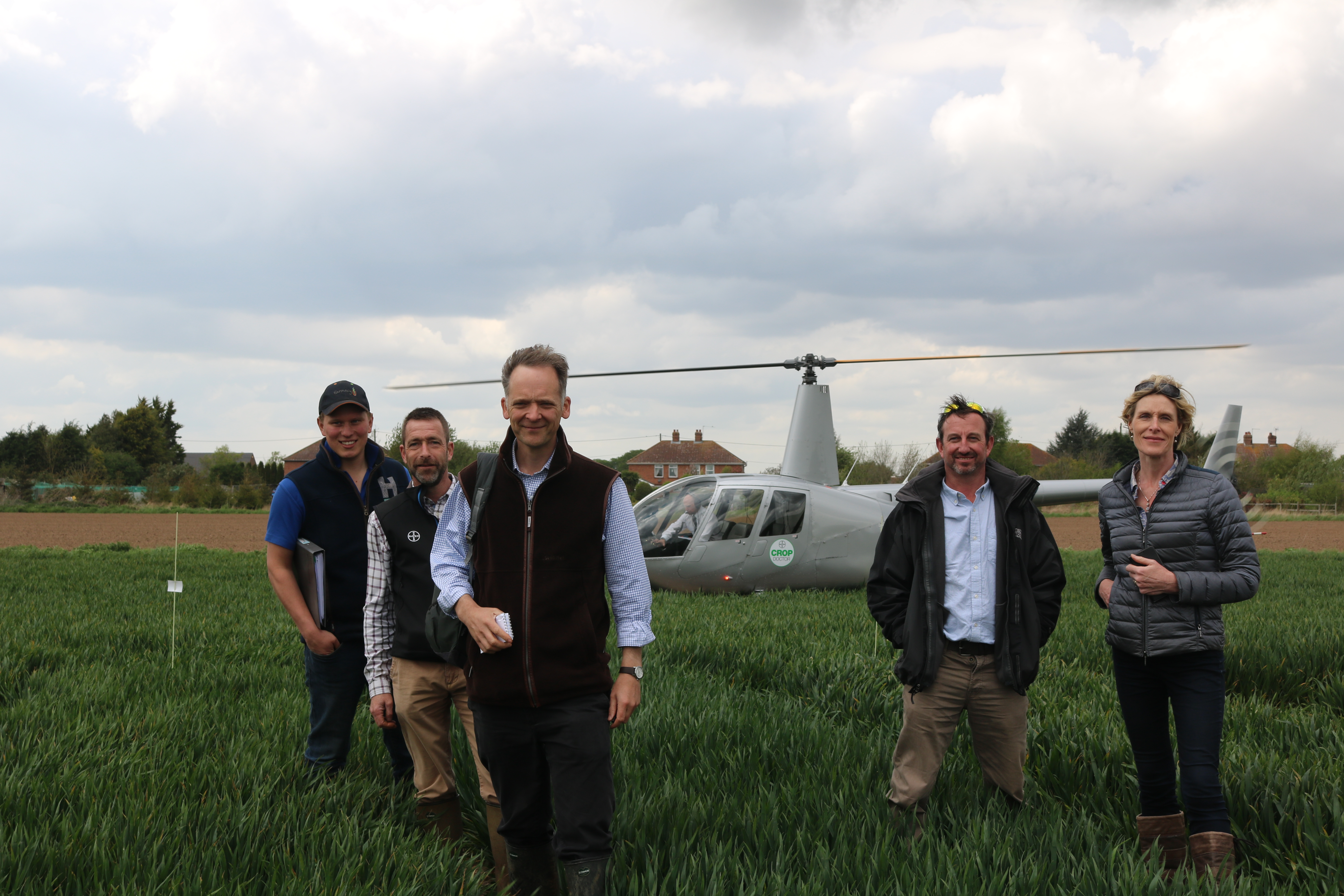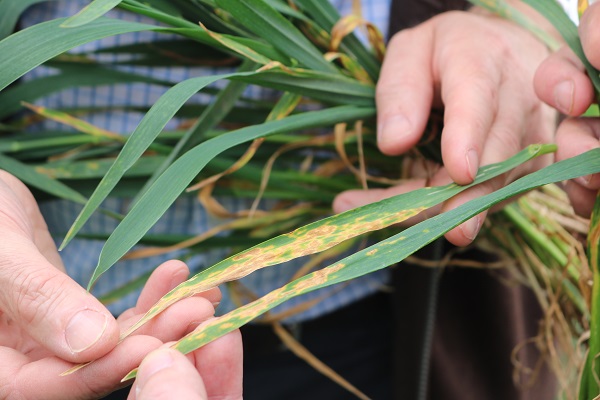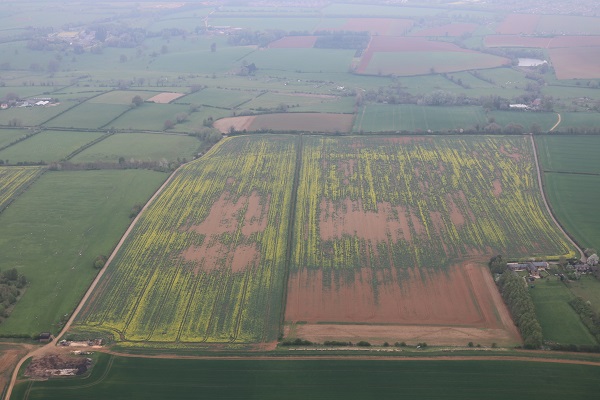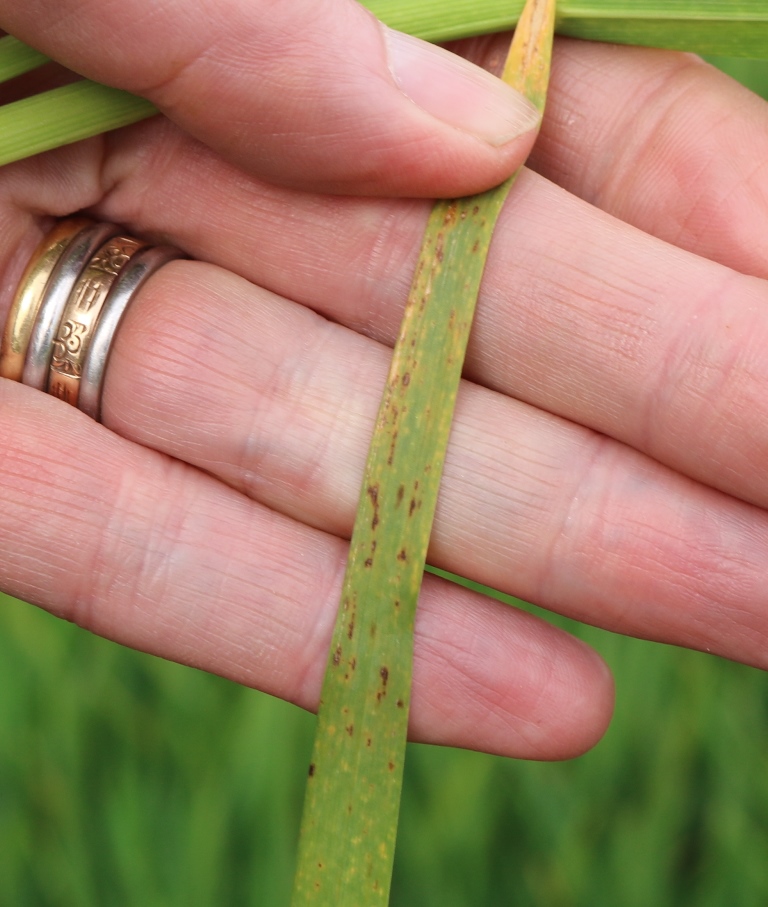
As T1 sprays are applied to wheat crops across the UK, CPM takes to the skies with Bayer’s Crop Doctors on the second tour this season of English trial sites.
We’re seeing high levels of eyespot and it’s worrying considering how dry it’s been.
By Tom Allen-Stevens
There’s almost a note of glee in her voice as Prof Fiona Burnett straightens up and presents stems of LG Sundance scarred by the characteristic brown ring of eyespot.
“We’re seeing high levels of eyespot and it’s worrying considering how dry it’s been,” she comments, as she passes the samples to Jonathan Blake of ADAS.
But he’s more concerned with septoria on the lower leaves he’s just pulled out of the untreated plot of Elation winter wheat at the Bayer trial site at Callow, Herefords. “Leaf four was just emerging the last time we were here and although it looks clean, it’s come through leaves on which septoria is now clearly well advanced,” he notes.

There’s just one week’s difference in sowing date between these two final leaf fives of Graham.
“That would also have exposed leaf three to infection, so where T1 sprays have been applied, they’ll need to be robust enough to clear up any latent infection.”
It’s 23 April and the two crop pathologists are inspecting the plots for the second time this season as part of Bayer’s Crop Doctor tour of England to assess crop growth and disease pressure prior to key fungicide timings.
The tour starts at Callow, where 50mm of rain fell on the distinctive reddish Bromyard series silty clay loam shortly after the Crop Doctors left the site in the first week of the month. “A similar amount fell in March, but it’s been dry for a fortnight,” says Bayer’s Gareth Bubb.
“There’s been enough to provide humidity in the canopy, which has kept disease going,” he reports, adding that most growers in the area applied T1 sprays between mid and late April.
His main concern, however, is for early drilled crops. “Even varieties with a high septoria rating have worryingly high levels of disease where they’ve been sown early, and that’s despite the low rainfall.”
To illustrate, he’s brought with him two well tillered plants of Graham, that were drilled a week apart at the end of Sept. There’s a clear difference between the level of infection on final leaf five. “What would exacerbate the problem is drilling a variety with a poor septoria score in the early slot. But not all robust varieties are suited to early drilling – Extase is a classic example of a variety that’s best drilled late if you want to make use of its high septoria disease score because of its growth habit,” he notes.

Few oilseed rape fields across the east of England haven’t suffered flea beetle damage. The Crop Doctor reckoned 50% is unaffected, 10% atrocious and the rest has suffered but will make a crop.
Local AICC agronomist David Lines joins the group, and agrees that growers in the West are best advised to focus first on septoria ratings before they look at yield scores when choosing a variety. “There’s no statistical difference between the highest yield performers on the AHDB Recommended List and those with the best septoria ratings. But note that a variety with an 8.1 for septoria drilled early will not live up to that rating.”
His other concern is for spray timings. “Crops have rocketed on in the fine weather, but earlier cold easterly winds checked growth. There could be well over a week’s difference in the ideal T1 timing for early and late sown wheats.”
Yellow rust is less of a concern in this part of the world, though. “Early on, varieties like RGT Gravity were looking filthy with septoria and mildew, but T0 sprays were applied to these crops. Those with higher disease ratings didn’t get a T0 spray, but adult resistance is kicking in, they’re growing away from any early infection.”
It’s time to take to the skies, and the Crop Doctors board the helicopter bound for the Great Tew Estate near Chipping Norton, Oxon. Here, farm manager Colin Woodward has two very different crops he brings the experts to – the first is a field of LG Sundance, drilled in mid Oct into a low-lying field of heavy, high magnesium clay. It received a T0 of Amistar Opti (azoxystrobin+ chlorothalonil) with chlormequat and Moddus (trinexapac-ethyl) just after the last Crop Doctor visit, and Colin’s left a small area unsprayed to see what disease is present.
“Disease levels aren’t as bad as we saw at Callow,” reports Fiona. “There’s septoria on the lower leaves, but what’s interesting is that there’s yellowing around the lesions. It may be that this variety is shutting down leaf growth around infections to limit spread of the disease.”
But again, eyespot is visible. “It’s at higher levels than we saw last time, and that’s a real worry,” says Jonathan. “Amistar Opti won’t have kept it in check, and that builds a case for an SDHI with prothioconazole at T1.”
Colin reveals he’s looking to spend around £30/ha on the T1 spray, with Ascra (bixafen+ fluopyram+ prothioconazole), Aviator (bixafen+ prothioconazole) or Elatus Era (benzovindiflupyr+ prothioconazole) as his options. “Leaf three is just emerging, so we’re still a week away from the ideal timing,” he says.
“We grow Sundance to spread the risk and extend the T1 window, but lodging is its weak point and this eyespot will make things worse. If Elatus was used at 50–60% rate I’d probably need to add more prothioconazole.” Jonathan notes that boscalid or a three-quarter rate of prothioconazole are the best options for eyespot, with GS31 the ideal timing.
The group moves up the hill, past the estate’s ironstone quarry, to an exposed sandy loam field of RGT Gravity, drilled at around the same time, with another area marked that didn’t receive the T0 Amistar Opti.
“The septoria here is more active,” reports Jonathan. “The lesions on the lower leaves have coalesced, and it doesn’t appear to be fighting the disease in quite the same way. This rather restores faith in Sundance’s higher disease rating.”
Fiona’s searching for eyespot, and eventually finds some. “It’s here, but it’s trickier to find than it was in the Sundance. But we’ve got mildew, and I don’t like the look of these spindly stems,” she comments.
As the Crop Doctors board the helicopter and take off, rain begins to fall – the first since early April, although soils across the estate are by no means running short of moisture. That’s in marked contrast to parched Grade 1 silts of Long Sutton near Spalding, Lincs – the next stop on the tour.
The rain clouds are left behind and David Hoyles, who greets the group and hosts the trial site, reveals the 8mm of rain that fell the day after the Crop Doctors’ previous visit was just about the only moisture the site has received throughout April.
“We decided against a T0 fungicide, applying just PGR and micronutrients at GS31,” he reports. “We had yellow rust in Jan, but the frost cleaned it up and we’ve had very little disease since. There’s usually some septoria bubbling away, but there’s not enough moisture for it, and we’ve dry easterly winds – it’s felt raw in the field.”
Half the farm’s 170ha of wheat has received its T1 spray of Adexar (fluxapyroxad+ epoxiconazole) and Bravo (CTL), with the rest due to be applied in the next 7-10 days.
The Crop Doctors confirm disease appears to have stopped in its tracks. “This is usually the worst site for disease, but it’s not as bad as it usually is,” says Fiona, who’s studying a final leaf six of Extase. “Growth wise, it’s further forward than we’ve seen at the previous sites, but there’s barely a lesion of septoria.”
Jonathan casts his agreement from the Elation plot. “This variety has the worst score for septoria, but levels here are the same as in more resistant varieties elsewhere. I’ve seen eyespot in Gravity and Sundance – whether it makes an impression will depend on what sort of May we have.”
Bayer’s Jack Hill and Darren Adkins guide the group to the worst rust spots in the plots. “Although it’s dried up, yellow rust initially came in around the earliest we’ve seen,” says Darren. “Given the right weather, it’ll quickly take hold again, so this crop needs its T1. Despite the recent dry conditions and low pressure, septoria still has to be the main concern for the season.”
Time for the final leg of the journey, and the Crop Doctors hop across the Wash and the Humber to Bayer’s large trial site at Cawood in Yorks. The firm’s Adam Tidswell greets the group and reports just 6mm of rain has fallen on the medium sandy silt loam during April, but as he speaks the first of a series of downpours falls from the sky.
Dr Phil Jennings from Fera also joins the group. He reveals the recent dry weather has been ideal for fusarium inoculum to build up on trash and he’s seeing signs of it at the stem base in crops. “Everything so far is pointing to a bad year for fusarium, but the crucial period will come in June – if it’s wet during flowering, that will bring the highest risk of disease.”
It doesn’t take Jonathan long to find eyespot. “This is the worst site for the disease,” he says. “In Gravity, final leaf six is the one infected with septoria, but due to the dry conditions, it’s not accelerated. The surprise to me is brown rust – I would have expected to find some and we’ve barely seen a pustule at any site.
“Yellow rust, however, is easy to find at low levels in susceptible varieties. It’s been checked by recent temperatures over 20°C, but could easily flare up if conditions allow or the T1 is compromised.
“That’s the easiest timing to misjudge, so if you’ve gone too early, you may find yourself in a curative situation at T2, and may even need a T1.5 to carry you through. T1 is also the last timing to control eyespot – it’s worrying how much we’ve seen of this disease and it could prove to be damaging this year.”
The good, the bad and the ugly candidates
New winter wheat Theodore from DSV looked to be the star performer in terms of disease across all three trial sites visited. It’s a potential Group 4 contender among the AHDB Recommended List Candidate varieties.
The Crop Doctors were hard-pushed to find much sign of disease in the variety at all, even at Callow. “What I like about this wheat is that it has a nice feel to it – good stout stems and a bold leaf,” adds Fiona.
It also looked very clean at Long Sutton, with a greener leaf than other candidates, right down to the base of the canopy. “You’d have to question whether there’s a case for an SDHI at all at T1 on this variety,” notes Jonathan.
A bit of mildew was found on the untreated RGT Lantern at Callow, but otherwise “relatively clean” was the verdict. Some of the other candidate varieties tended to disappoint, however. “In terms of septoria performance KWS Kinetic and KWS Extase are like chalk and cheese,” comments David Lines. “But the candidate variety is still a lot cleaner than Gravity.”
At Long Sutton, Jack notes that many varieties beginning with a K or G look bad for yellow rust, which goes as much for candidates as those fully recommended. Plots of untreated LG Rhythm, a potential Group 3 candidate last year, had plenty of yellow rust at Long Sutton and Cawood, with the disease also making a surprise showing in LG Graduate at Callow. “If this performance plays out, I don’t think it will graduate,” comments Fiona.
It was RGT Wasabi that was recommended for special measures, however. “The yellow rust on Wasabi is as bad as we’ve seen in Reflection,” says David Lines. The Wasabi plot also stood out for all the wrong reasons at Long Sutton and Cawood.
Don’t judge a variety by its disease cover
The Crop Doctors were put to the test with pots of four varieties dug from Bayer’s trial site at Hinton Waldrist, Oxon. The firm’s Ben Giles presented the late-Oct drilled Elation, KWS Santiago, KWS Extase and Graham, and challenged the experts to identify them by the level of disease.
“Bizarrely the two varieties with the higher septoria ratings are actually the dirtiest at the moment,” states Ben, finally revealing the names, none of which have been identified correctly. “But I think that’s because this late drilled Extase has grown well and it’s lush. As the season plays out, I think the pecking order will reverse in terms of disease.
“It may also be a mistake to judge a variety by disease levels on final leaf six,” he continues. “Leaf three of a strong-rated variety will have a better chance of coming clean through a dirty canopy than one with a poor septoria score.”
Fiona notes that RL ratings are only one indication of the level of disease you’re likely to find in a variety, with sowing date, site, cropping history and other factors all having a bearing.
Jonathan points out that RL disease monitoring takes place in June. “You can see a switch in performance just between the beginning and end of that month.”
Spotting a diversion in barley
 Abiotic stress spotting in KWS Cassia at Cawood can easily be misidentified as ramularia, notes Fiona. “It’s a bit early for ramularia, and this is most likely due to cold winds and the dry conditions, putting the crop under stress.
Abiotic stress spotting in KWS Cassia at Cawood can easily be misidentified as ramularia, notes Fiona. “It’s a bit early for ramularia, and this is most likely due to cold winds and the dry conditions, putting the crop under stress.
“But the symptoms aren’t correct for the disease. You need to look for the 5Rs: Rings of chlorosis, rectangular in shape, restricted by leaf veins, of a reddish-brown colour and right through the leaf. In this instance, you can see the spots don’t go right through the leaf and they aren’t bound by the veins.”
Ramularia is a disease growing in significance. Infection generally doesn’t show until towards the end of season, at which point it can bring on senescence by as much as two weeks, cutting yield by up to 0.5t/ha. “CTL is now the only fungicide with any effect, so the active’s loss of approval will cause problems. At SRUC, we’re looking into how the use of biostimulants can help, as ramularia is a disease brought on by stress.”
There’s a small amount of rhynchosporium in susceptible varieties, which is not unsurprising, but otherwise Fiona’s buoyed by the low levels of disease found. “T1 is the main spray timing for barley, and most should now have been applied. An SDHI/prothioconazole mix is best to keep rhyncho under control.
“Use the T2 timing (awns just emerging) to keep a lid on infection, and adding CTL for ramularia is a good idea. Don’t lose sight of rhyncho and net blotch, however, as these will stress the crop and bring on a ramularia infection,” advises Fiona




